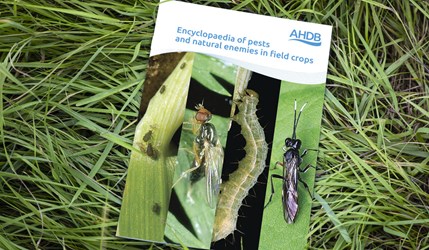- Home
- Knowledge library
- Encyclopaedia of pests and natural enemies
Encyclopaedia of pests and natural enemies
The encyclopaedia provides at-a-glance information on the pests and natural enemies associated with cropping systems.
Our encyclopaedia details the major and minor pests and natural enemies commonly associated with cropping rotations. Use it help prevent, detect and control pest populations in field crops, as part of an integrated pest management (IPM) strategy.
The landmark publication is the result of collaboration between AHDB’s crop sectors – cereals and oilseeds, horticulture and potatoes – respected crop entomologists and a host of other leading organisations, including BBRO and PGRO.
The heavily illustrated publication covers hundreds of crop pests (including beetles, bugs, aphids, flies, moths, butterflies and nematodes) known to affect one or more of the following crops – alliums, carrots, cereals, field beans, lettuce, oilseed rape, peas, potatoes, sugar beet and vegetable brassicas.
For each pest, the latest information on the importance of the pest to cropping is presented as well as information on identification, risk factors, life cycle, monitoring, control thresholds, non-chemical control and insecticide-resistance status (where known).
Explore the encyclopaedia
Minor and/or emerging pests
How to encourage natural enemies of pests
Natural enemies (beneficial organisms or 'beneficials') are a key component of IPM. Our guidance contains descriptions and images of natural enemies, and describes ways to farm to help promote a balance between pests and their predators. Central to this is the 'SAFE' approach (shelter, alternative prey, flower-rich habitat, environment).
 Jon Oakley.JPG) Jon Oakley
Jon Oakley
IPM: the three main programme components
Prevent – suppress pest populations and the risk of economic damage. For example, use natural enemies, sow resistant varieties and manage rotations.
Detect – monitor pest/beneficial populations to determine when chemical control is justifiable. Includes the use of crop inspections, pest trapping, forecasts and thresholds.
Control – return pest populations to below damaging levels. Prioritise biological and physical methods over chemical interventions, where possible. Always manage environmental and resistance risks associated with the use of plant protection products.




.PNG?v=637780261920000000)







 Fera.JPG?v=637780262040000000)